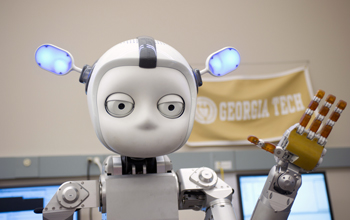Multimedia Gallery
National Robotics Initiative research (Image 3)
Simon the robot was developed by Georgia Institute of Technology researcher Andrea Thomaz, whose research is funded by the National Science Foundation (NSF). Using Simon as her student, Thomaz is redefining how robots and humans interact. She sees a future where any "naive user" (or nonprogrammer) could buy a robot, take it home and instruct it to do almost anything. But for this to work, robots need to think like naive users. So Thomaz invites people from off the street to teach Simon at her Georgia Tech lab. Lessons include everything from clearing the dinner table to sorting objects by color. Based on the results, Thomaz tweaks Simon's algorithms to make him a more efficient communicator and learner.
Funding comes from the National Robotics Initiative (NRI) launched with NSF as the lead federal agency in partnership with the National Institutes of Health, the U.S. Department of Agriculture (USDA) and NASA to develop robots to work with people to enhance individual human capabilities, performance and safety. Projects target the creation of next-generation collaborative robots, or co-robots, for advanced manufacturing; civil and environmental infrastructure; health care and rehabilitation; military and homeland security; space and undersea exploration; food production, processing and distribution; independence and quality of life improvement and driver safety.
Further information about NSF support of NRI is available in the NSF press release National Robotics Initiative invests $38 million in next-generation robotics. [Research supported by NSF grant IIS 13-17775.] (Date of Image: 2012) [Image 3 of 3 related images. Back to Image 1.]
Credit: Georgia Institute of Technology
See other images like this on your iPhone or iPad download NSF Science Zone on the Apple App Store.
Images and other media in the National Science Foundation Multimedia Gallery are available for use in print and electronic material by NSF employees, members of the media, university staff, teachers and the general public. All media in the gallery are intended for personal, educational and nonprofit/non-commercial use only.
Images credited to the National Science Foundation, a federal agency, are in the public domain. The images were created by employees of the United States Government as part of their official duties or prepared by contractors as "works for hire" for NSF. You may freely use NSF-credited images and, at your discretion, credit NSF with a "Courtesy: National Science Foundation" notation.
Additional information about general usage can be found in Conditions.
Also Available:
Download the high-resolution JPG version of the image. (3.4 MB)
Use your mouse to right-click (Mac users may need to Ctrl-click) the link above and choose the option that will save the file or target to your computer.

